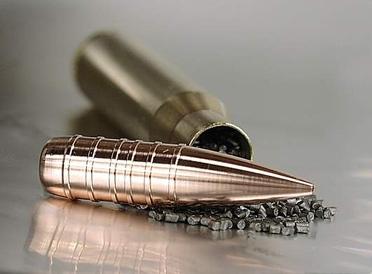

 The Accurate Reloading Forums
The Accurate Reloading Forums  THE ACCURATE RELOADING.COM FORUMS
THE ACCURATE RELOADING.COM FORUMS  Guns, Politics, Gunsmithing & Reloading
Guns, Politics, Gunsmithing & Reloading  Bullet Making
Bullet Making  Re: Bullet Jacket material
Re: Bullet Jacket materialGo  | New  | Find  | Notify  | Tools  | Reply  |  |
| one of us |
Probably the copper alloys are best for our application but I too share some curiosity on the subject. I'm not certain what alloys accept swaging but note that driving bands on artillery are mostly copper, at least from my era. The one that intrigues me most is that material used in the sabots for the M1 main gun. Anybody know what that is??????? There is a significant problem of scale in trying to use driving bands on small arms projectiles. An error of a few thousandths of an inch in a 155mm shell is of small note regarding bore alignment(run out), in small arms projectiles it is unacceptable, and I suspect that maintaining tolerances of even a few thou. would be problematic. Then there is the issue of matching bore size to projectile diameter... BC's? See Ya! Perhaps polycarbonates would be more amenable to the process but fouling rears it's head there. It is an area with potential but IMO there are great problems associated with current materials and technology. I think the most immediate potential for improvement lies with denser core materials and/or redistribution of weight within the projectile to enable slower twist rates. | ||
|
| one of us |
Lets play 'What cha think' If I swaged a lead core or some maybe some harder denser material into the shape of an auto head valve stem. Dropped a copper washer over the valve stem shank, reswaged the whole unit so the shank swaged down around the copper washer, leaving a 1/4 inch of hard alloy washer diameter then another shank. Drop another washer over the shank and swage the remainder of the shank into the desired nose shape. Wallah, we have a hard dense core with copper driving bands. This was attempted using cast bullets with a modified gas check dropped into the mold prior to casting the bullet. Now replace the copper washer with a Teflon washer or maybe a Nylon washer to serve the same purpose. Maybe the lead compressing the Nylon/Teflon would extrude the Nylon/Teflon uniformly each time to have one half of one thousandth extending beyond the lead core. Hmm, got called to dinner I'll be back. Jim | |||
|
| one of us |
Back, it was a great dinner, having a girl friend sure is more pleasant then having a wife. The girl friends still try to impress. Back to important things. Could a jacketed covered core be ringed with the driving bands, achieving the the benefits of the jacketed bullet with the lower friction of the lubricating Nylon/Teflon giving lower pressures and higher velocity. Or using copper as the driving band , but having less of the bullets surface in contact with the barrel. Jim | |||
|
| one of us |
arkypete Gilding metal (a brass 90/10) and even pure copper has a fairly low Coef. of friction on steel. Probably about as good as its going to get (besides nakid lead/bearing alloys of tin/ silver / antmny) The problem with plastics is thermal breakdown leading to being off-center while traveling down the bore. Also, when bullet and bore become too slick, you run out of powder... Like moly coat... reduces pressure, you add powder to gain it back. Yeah you get more velo *if* you dont run out of case. Of course you can always play with faster powders. just some thoughts | |||
|
| one of us |
Smallfry Sorry for not responding quickly. Between Christmas and pondering your post... Some of the bronzes may warrant exploring. The bronzes are harder alloys of copper, like cartridge brass. Using a different bullet design, a design taking into account the hardness and difference in lubracy (SP). As I see it, the current level of developement of ammo is stumped at this level of speed, bullet weight, etc. If the jacket material is changed, say steel bonded to copper, brass, bronze, like the old Norma Triclad and a different shape could give us the ability to reach the next level of developement. A bullet shape that had a 1/3 bullet length bearing surface with the rest just bore riding or having a Nylon/Teflon sleeve. I'm tinkering with a cast bullet design that has this profile. It starts out as a round nose to a .301 and gradually tapers up to .305 step then up to the .311 full diameter. My idea there was to be self centering in the lands. I'll do some tinkering and report back. Jim | |||
|
| Powered by Social Strata |
| Please Wait. Your request is being processed... |
|

Visit our on-line store for AR Memorabilia

